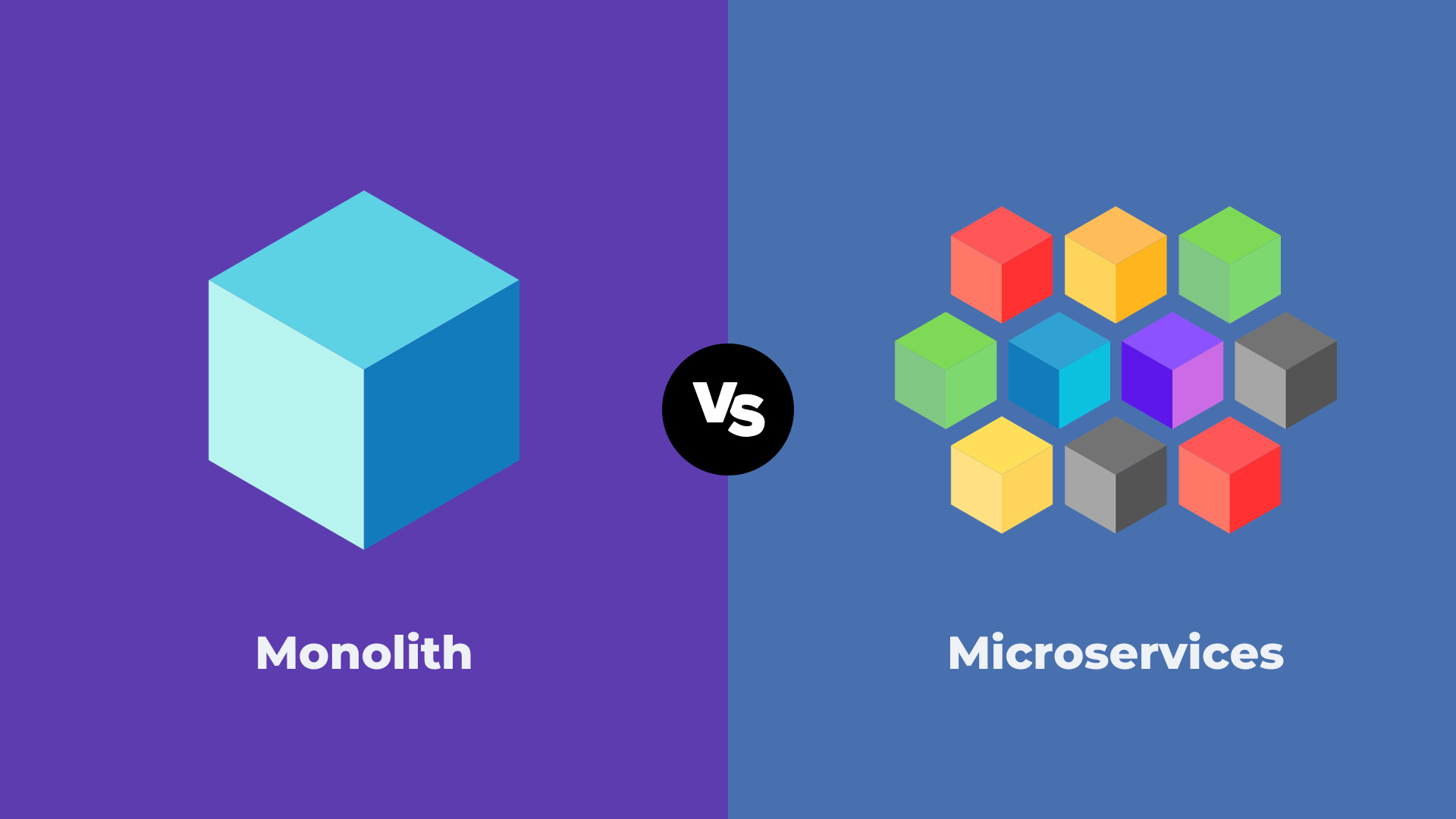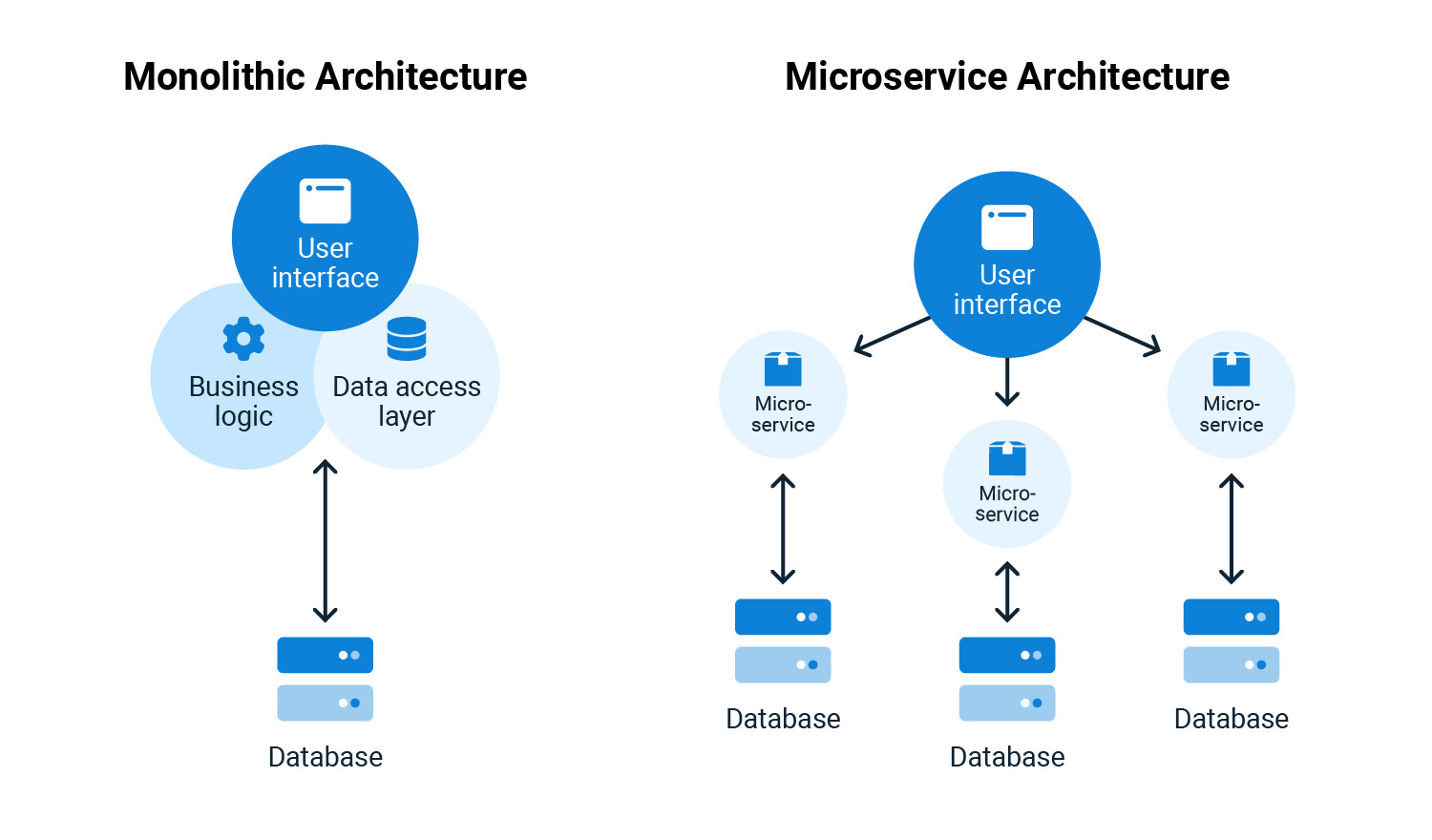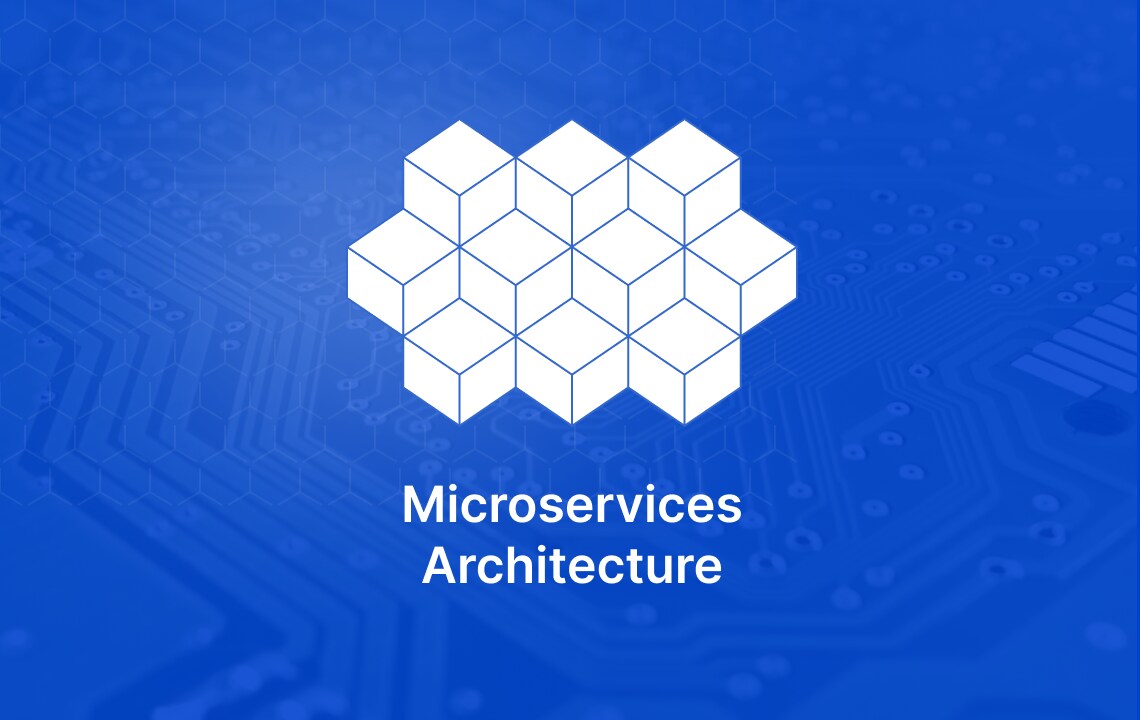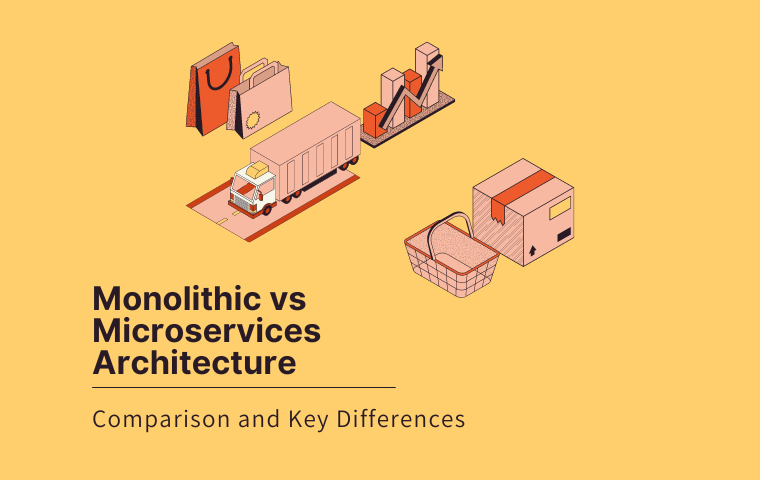TABLE OF CONTENT
Overview about Monolithic vs Microservices architecture
Between Monolithic vs Microservices architecture: Which differences?
Overview Table Comparison between Monolithic vs Microservices Architecture
When to Use Monolithic vs Microservices architecture?
How to Migrate From Monolithic to Microservices architecture?
Conclusion
Overview about Monolithic vs Microservices architecture

About Monolithic architecture
Monolithic architecture, when comparing between monolithic vs microservices architecture, is a traditional approach to building and designing software applications. The special thing about this type of architecture is that all components of the stores on the platform are tightly integrated and deployed as a single unit.
In a monolithic architecture, all the components that make up your ecommerce stores, including the user interface, data access layer, and business logic are developed, tested, operated, and deployed into a single unit. This architectural style is especially dominant in the early stages of store development, in a complex market like ecommerce.
Pros
- Simplify the deployment process with an all-in-one model
- Reduce communication costs
- Focused development
- Easy check in
Cons
- Limited scalability
- Limited flexibility in applying technological achievements
- Difficulty in maintaining large code bases
About Microservices architecture
Microservices architecture, between monolithic vs microservices architecture, is a way of dividing digital stores into many small services that can be deployed independently. Each microservice will be responsible for a specific area (for example: microservice responsible for payment gateway, microservice responsible for inventory management, etc). Microservices will communicate with each other through APIs.
This architecture promotes modularity, flexibility, and outstanding scalability. They also do not cause synchronization errors throughout the system and are easy to detect and fix if an error occurs.
Pros:
- Outstanding scalability
- Diverse forms of technology application
- Fault isolation
- Continuous deployment
Cons:
- Complexity of distributed systems
- Can increase operating costs
Between Monolithic vs Microservices architecture: Which differences?
Between monolithic vs microservices architecture, there are many distinct differences.
Ability of extension
Monolithic architecture
With monolithic architecture, expanding an ecommerce store often requires changing the entire existing code base. Besides, if you wish to add new features or functions, you must thoroughly check its compatibility with the entire online application. Otherwise, it can lead to potential store system disruptions, greatly affecting the seamless customer experience.
Microservices architecture
In contrast, microservices architecture, when comparing monolithic vs microservices architecture, inherently allows for maximum ecommerce business scalability due to its modular nature. Each microservice takes care of a different specific business function, allowing you to independently deploy and scale one or more services as desired.
In particular, this behavior does not affect the entire system. This unique approach allows for exceptional flexibility, and businesses also save maximum time to expand their storefronts.
Fault isolation capabilities
Monolithic architecture
With monolithic architecture, fault isolation is limited because all components are tightly integrated and operate on a single entity. If just one setting or small part of an application fails, it can affect the entire system, making it difficult to isolate and specifically resolve the problem.
Finding and debugging errors can also be very time consuming and require radical complexity. The reason is because changes in one small area, when not detected in time, can cause serious injuries to the overall ecommerce store. When the problem becomes too large and spreads over a large area, determining the root cause and core of the problem becomes more difficult than ever.
Microservices architecture
Microservices, on the other hand when comparing monolithic vs microservices architecture, excel at fault isolation due to their decentralized nature of operations. Each microservice takes on a different task and operates independently, so its failure will not directly affect other services in the same ecommerce system. This way of working allows business owners or developers to quickly detect errors and quickly fix them.
In particular, this process will not affect the operations of other microservices, avoiding hindering the operations of the overall ecommerce business.
Complexity in deployment and operation

Monolithic architecture
Deploying and operating an ecommerce business in monolithic architecture is relatively simple, because all components have been packaged and deployed as a single unit. This simplicity allows businesses, especially at the small and medium level, to easily grasp and manage on an overall scale.
Of course, this management approach can also become outdated when you want to add complex features to your stores’ operations. You need to consider redeploying the entire application to integrate that feature, and thoroughly check whether it will negatively affect other functions of the ecommerce store. Operational risk and potential downtime are consequences that you must pay special attention to.
Microservices architecture
Deploying and operating with a microservices architecture is more complex compared to monolithic vs microservices architecture, as you need to manage multiple independent services at the same time.
With different tasks and functions, each microservice needs to be deployed, specifically monitored and scaled separately. It requires more powerful infrastructure and orchestration tools than usual, such as Docker or Kubernetes.
At the same time, professional technical expertise and operational experience, DevOps practices are not only required, but also demands excellence and familiarity with each ecommerce platform. That’s the reason why many business owners choose to cooperate with an ecommerce consulting agency.
Of course, expansion will also be more flexible with microservices architecture. It allows you to make specific changes at any time to enhance the functionality of your ecommerce store without worrying about affecting the overall operating system.
Maintenance costs
Monolithic architecture
Initial maintenance costs can be lower with monolithic architecture when comparing monolithic vs microservices architecture, as you only need to manage a single code base and unify the deployment process across the entire ecommerce business. However, as applications expand, grow, and become more complex, maintenance costs can skyrocket. The system is tightly linked, so in the event of changes, the risk of errors affecting the entire business will be higher.
Microservices architecture
Maintenance costs with microservices architecture will be broken down into each microservice. Initially, this cost will be quite high due to the need for more complex infrastructure and management tools. Each microservice also requires independent maintenance, monitoring, and scaling, leading to increased overall costs.
However, in the long run, you will not have to pay additional costs for functions and services that you do not use. Good control of operations and immediate correction of errors will also reduce long-term maintenance costs and ensure efficient use of resources.
Development speed
Monolithic architecture
Development speeds in monolithic architecture are faster when comparing monolithic vs microservices architecture due to the simplicity of a single code base, and the need to focus only on monitoring overall operational quality. Developers can easily visualize the entire system’s workflow, easily navigate and speed up its operating cycle.
However, this can become a bottleneck that prevents the future extensive development of ecommerce businesses. This situation occurs based on the dependency of a service on the overall application, which risks affecting the expansion process due to the complexity of integrating new features.
Microservices architecture
Benefiting from its modular nature, businesses using microservices can grow at an incredibly fast pace. Each microservice can be developed, tested, and deployed completely independently, facilitating simultaneous development of multiple features at the same time.
This decoupling reduces dependency on the overall system, and allows flexible response to changing business operations.
The process of changing and upgrading microservices will require time and high complexity. You must really understand what your goals are when upgrading that microservice, and understand the basic requirements when upgrading (for example, software or infrastructure requirements). The time to upgrade platform elements also needs to be noted.
Flexibility
Monolithic architecture
Flexibility will definitely be limited when using a monolithic architecture due to the tight integration of the code base. In particular, incorporating new technologies will be challenging, as it requires careful consideration of the structure and dependencies of the entire application. The rigidity and standardization of relying on one and only one code base will make it difficult to scale up or change flexibly according to market trends.
Microservices architecture
In contrast when comparing monolithic vs microservices architecture, flexibility is a typical advantage and highlight of microservices architecture. This architecture allows you to choose the technology platform and framework that best suits each microservice without affecting the rest of the digital store.
Modularity allows for faster adaptability without spending too much time on upgrades and quality control. This capability will deliver exceptional performance, especially for businesses that aim to grow flexibly and continuously scale to meet customers’ changing preferences every second.

Overview Table Comparison between Monolithic vs Microservices Architecture
Below is an overview table comparison between monolithic vs microservices architecture:
| Aspects | Monolithic Architecture | Microservices Architecture |
| Ability of Extension | Difficult to scale with an uniform operational architecture | Easily expand with independent services |
| Fault Isolation Capabilities | Poor isolation ability, a small error can affect the operation of the entire system | Errors are thoroughly isolated to individual microservices |
| Complexity in Deployment and Operation | Deployment is simple but can become complex and cumbersome when developing at scale | Requires complex coordination due to connections between independent microservices |
| Maintenance Costs | Maintenance costs are lower initially but can increase when expanding or errors arise | Allocate maintenance costs according to the activities of each microservice, more effective in the long run |
| Development Speed | Faster in the beginning but slows down as it scales, increasing in complexity | Supports rapid and concurrent development of individual microservices |
| Flexibility | Flexibility is limited due to the unified code base | High flexibility with modular services and operations |
When to Use Monolithic vs Microservices architecture?
Use Monolithic architecture if …

You should consider using monolithic architecture between monolithic vs microservices architecture in case your ecommerce business is small in size, has a clearly defined scope of operations over a certain period of time, and prefers simplicity.
It is also suitable when you orient your digital store to a fixed roadmap, focus on providing services to a single customer file and temporarily do not scale too large. This helps you focus on overall business operations and improve operational efficiency.
Use Microservices architecture if …

You should really choose to use microservices architecture when your business is in a period of rapid growth. In particular, you require high flexibility and thorough technology application to operate openly and easily apply new technological changes according to market trends.
This approach allows your business to improve fault isolation, scalability, and the ability of each microservice to handle work independently.
How to Migrate From Monolithic to Microservices architecture?
When a monolithic architecture business expands and wants to increase its ability to spread, migrating the store to using microservices architecture will be a key solution to ensure outstanding scalability and compatibility.

You can refer to the steps to migrate monolithic vs microservices architecture listed below:
Step 1: Overall assessment and planning
Carefully analyze the effectiveness and problems of monolithic architecture when applied to your digital store at the present time. From the data collected, create a detailed migration plan that clearly outlines the scope, goals, and timeline. Carefully mark which parts need to be prioritized for early migration to establish the first microservices, which are the core of the ecommerce business.
Step 2: Perform Proof of Concept (POC) steps
Thoroughly understand the POC process to effectively move data from stored monolithic architecture to microservices architecture. Start moving with small, non-critical components of the monolithic architecture to transform into a microservice.
This approach will help you identify potential problems that may occur during the migration process, thereby finding ways to improve to prevent unnecessary errors. Thoroughly examine innovative tools, infrastructure, and technologies for implementing migrate monolithic vs microservices architecture.
Step 3: Gradually move items in the ecommerce store
Gradually move the elements in your stores. Make sure each new microservice is thoroughly tested and tightly integrated into your ecommerce store. You should use APIs to enable communication between microservices and small parts of the monolithic architecture without disrupting the flow of the entire system.
Step 4: Test, optimize and evaluate feasibility in scaling
After a successful migration, once again check the performance of the microservices. Focus on optimizing performance and scalability. Thoroughly monitor and record performance for at least the first 1-2 weeks for strong management and identify errors, if any.
A note for you, that this migration process is really extremely complicated. If you don’t have in-depth technical knowledge, you should consider partnering with ecommerce development companies/agencies to ease and optimize this overall process.
Conclusion
The difference between monolithic vs microservices architecture has been clearly pointed out in the article above. These two architectures have completely different properties, targeting different audiences and purposes. You should understand the basic knowledge as well as dig deeper to make the most suitable choice for the operating direction of your ecommerce business.
Don’t worry if you’re still confused and confused, because we, AHT Tech, are always here to help you. Focusing in-depth on the ecommerce development activities with 1000+ ecommerce projects, 500+ experts and being a partner of 25+ ecommerce global platforms, we are confident in our solid expertise in monolithic vs microservices architecture, ensuring the consulting and operating process of your ecommerce business will be most complete no matter what architecture.
Contact us immediately for more detailed information about these two architectures and don’t miss this video below about our ecommerce service:



